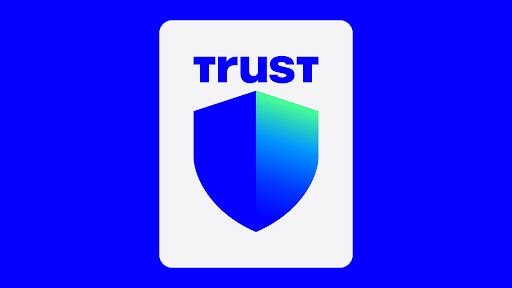So I was fiddling with different crypto wallets on my phone the other day—yeah, the usual hustle of juggling coins and tokens—and something about Trust Wallet just clicked. Wow! It’s not like your average app cluttered with features nobody uses. Nope, this one feels like it actually *gets* what mobile crypto users need. Seriously?
At first glance, Trust Wallet looks pretty straightforward. Minimalist design, clean interface, and—get this—a built-in dApp browser. That last part caught me off guard. Why would a wallet need that? My instinct said it was just a gimmick, but then I dove in a bit deeper. Turns out, having direct access to decentralized apps right inside your wallet is a total game-changer for folks who want to do more than just hold coins.
Here’s the thing—managing multiple cryptocurrencies on mobile can be a headache. You want security, but also flexibility. Initially, I thought Trust Wallet was just another multi-coin wallet, but it actually nails the balance between ease of use and powerful features. And yeah, the whole setup process was super smooth, which surprised me. Usually, these things get complicated real fast.
Digging into its security model, I noticed Trust Wallet doesn’t hold your private keys on any server. Everything stays on your device. Hmm… that’s reassuring, but it also means you’re solely responsible for backups. I’m not gonna lie, that part bugs me a bit because losing your recovery phrase can be disastrous. Still, that’s pretty standard in crypto wallets, so you gotta be careful.
Another thing I really appreciate is the wallet’s support for a wide range of coins—from the big names like Bitcoin and Ethereum to some less mainstream tokens. This flexibility feels very much in line with what I expect from a modern crypto wallet, especially one optimized for mobile users who want to keep everything in one place without switching apps constantly.

Okay, so check this out—Trust Wallet’s built-in dApp browser isn’t just a neat add-on; it opens up a whole world of decentralized finance (DeFi) and NFT platforms right at your fingertips. You don’t have to leave the app to explore or interact with these decentralized services. This integration is pretty slick, though I did notice some dApps feel a bit clunky on mobile, but hey, that’s more on the dApp developers than Trust Wallet itself.
From a usability standpoint, the wallet offers a straightforward swap feature, which is handy when you want to exchange tokens quickly without hopping onto an exchange. But, heads up—fees can be a bit steep depending on the network congestion. Something felt off about the timing of certain swaps, probably due to blockchain delays. It’s not a dealbreaker, but something to keep in mind if you’re in a rush.
Initially, I thought the wallet might be too basic for power users, but then I realized it actually caters well to both beginners and more experienced folks. The interface doesn’t overwhelm you, but under the hood, there’s enough muscle to handle complex transactions and token management. On one hand, this simplicity is great; on the other, I wish there were more customization options for advanced users.
Why Mobile Users Should Give Trust Wallet a Shot
So here’s where I get a little biased—I’ve always preferred wallets that put control firmly in the user’s hands. Trust Wallet does exactly that. It’s non-custodial, which means no middlemen. You’re the boss. No weird surprises with frozen funds or shady policies. This autonomy is very much the spirit of crypto, and it’s refreshing to see it done right on mobile.
That said, I’m not 100% sure it’s perfect for everyone. For example, if you’re a newbie who’s not great at backing up keys, it might be a bit intimidating. But if you can get past that, the wallet’s design feels intuitive. The learning curve is gentle enough to keep you from feeling lost, yet the features grow on you as you explore more complex crypto activities.
Speaking from personal experience, syncing Trust Wallet with hardware wallets was a pleasant surprise. It’s not something I expected on a mobile app, and it really helps bridge the gap between convenience and security. Not many mobile wallets offer this kind of integration, which makes Trust Wallet stand out.
Check this out—if you want to explore Trust Wallet yourself, you can find all the details and official downloads here. I like that it’s transparent and straightforward, nothing sketchy lurking beneath the surface.
But let me be real—no wallet is flawless. Sometimes the app updates can introduce bugs that slow things down or mess with transaction speeds. And while the dApp browser is powerful, it’s not as refined as desktop alternatives. Still, given the pace of crypto innovation, these are growing pains rather than dealbreakers.
In the end, Trust Wallet feels like the mobile crypto wallet that respects your time, your coins, and your need for flexibility. It’s a toolkit for the modern crypto user who’s on the move but refuses to sacrifice control or security. Honestly, I didn’t expect to be this impressed at first, but now it’s one of the first apps I recommend when friends ask about managing crypto safely on their phones.
Frequently Asked Questions About Trust Wallet
Is Trust Wallet safe to use on mobile devices?
Yes, Trust Wallet is a non-custodial wallet, meaning your private keys are stored locally on your device, not on any server. However, it’s crucial to back up your recovery phrase securely because losing it means losing access to your funds.
Can I use Trust Wallet to interact with decentralized apps (dApps)?
Absolutely. Trust Wallet includes a built-in dApp browser that allows you to connect to various DeFi platforms, NFT marketplaces, and other decentralized services directly within the app, making mobile crypto experiences more seamless.
Does Trust Wallet support multiple cryptocurrencies?
Yes, it supports a wide variety of cryptocurrencies across different blockchains, including Ethereum, Binance Smart Chain, Bitcoin, and many others, allowing you to store and manage multiple tokens in one place.







